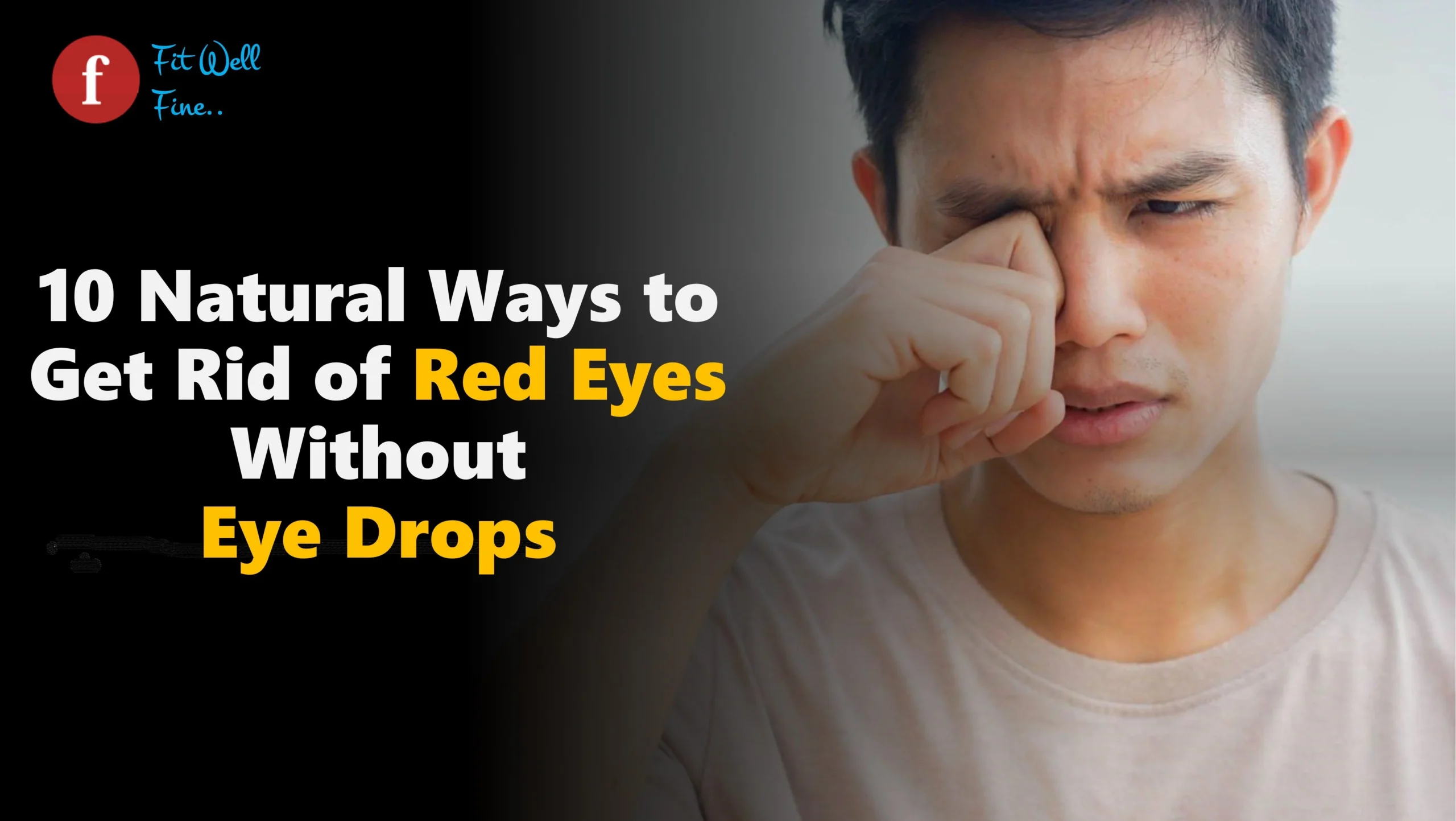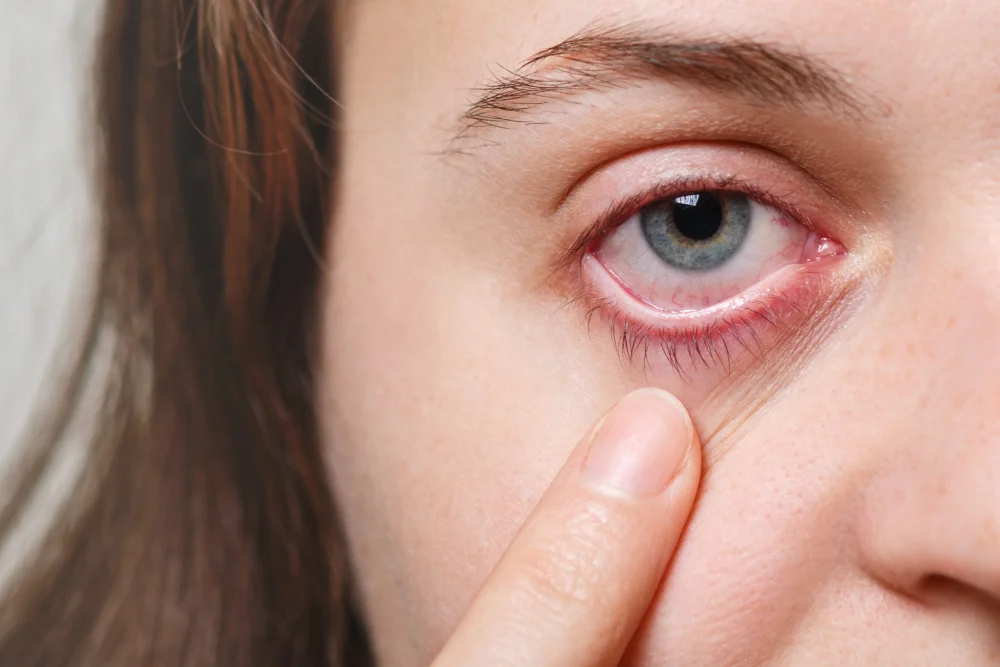Are your eyes feeling dry, itchy, and red? Red eyes can be caused by a variety of factors, including allergies, lack of sleep, and eye strain. But before you reach for the eye drops, consider some natural remedies that can help alleviate red eyes without the use of harsh chemicals. In this article, we’ll explore some natural ways to get rid of red eyes without the use of eye drops.
Understanding Red Eyes
Before we dive into the home remedies, let’s understand about red eyes including the common causes and symptoms.
Red eyes are a condition in which the blood vessels on the surface of the eye expand or dilate, causing the sclera to turn red. This can be a sign of inflammation, infection, or injury to the eye. In some cases, red eyes can be a symptom of an underlying medical condition such as conjunctivitis, corneal ulcers, or uveitis. (1)
Treatment for red eyes depends on the underlying cause and may involve the use of eye drops, medications, or natural home remedies such as cold compresses or herbal remedies.
Causes for Red Eyes
Before we dive into the remedies, let’s understand the common causes of red eyes. Some of the common causes include: (2, 3)
1. Allergies
Allergies are one of the most common causes of red eyes. Exposure to allergens like pollen, dust, or pet dander can trigger an allergic reaction, causing your eyes to become red and itchy.
2. Lack of Sleep
Not getting enough sleep can cause your eyes to become red and puffy. When you don’t get enough rest, your body produces more cortisol, a stress hormone that can lead to inflammation.
3. Dry Air
Dry air can cause your eyes to become irritated and red. This is particularly true if you spend a lot of time in air-conditioned rooms or live in a dry climate.
4. Eye Strain
Staring at a computer screen or reading for long periods can cause eye strain, which can lead to red eyes.
5. Infections
Infections like conjunctivitis or pink eye can cause your eyes to become red, swollen, and itchy. If you suspect an infection, it’s important to see a doctor for proper diagnosis and treatment.
6. Glaucoma
In glaucoma, the increased intraocular pressure damages the optic nerve and causes the blood vessels in the eye to become enlarged, resulting in redness.
7. High blood pressure
High blood pressure can cause the small blood vessels in the eyes to become enlarged, leading to a reddish appearance.
Symptoms of Red Eyes
Red eyes and itching are a condition where the sclera (the white part) of the eye appears red or pinkish in color. Some common symptoms of red eyes include: (4, 5)
1. Bloodshot appearance
The most common symptom of red eyes is the appearance of blood vessels in the eye, giving the eye a reddish or pinkish appearance.
2. Itching
Itching is one of the common symptoms associated with red eyes. Rubbing your eyes can worsen the itching and lead to further irritation, so it’s important to resist the urge to rub your eyes.
3. Eye discomfort
Red eyes can be accompanied by discomfort, including itching, burning, and a feeling of dryness or irritation.
4. Watery eyes
It can also cause excessive tear production, leading to watery eyes.
5. Blurred vision
In some cases, red eyes may also cause temporary blurring of vision.
6. Sensitivity to light
It can also cause sensitivity to light, making it uncomfortable to be in bright environments.
7. Eye discharge
In some cases, red eyes may also be accompanied by a discharge, which can be clear or colored.
8. Eye pain
Severe cases of red eyes can cause eye pain, which may be accompanied by headaches.
10 Natural remedies to Get Rid of Red Eyes without Eye Drops

There are several natural ways to get rid of red eyes without using eye drops. Here are some effective red eyes home remedies that you can try using-
1. Cold Compress for red eyes
To get rid of redness around the eyes, you can try using a cool compress. A cold compress can help alleviate red eyes by reducing inflammation and soothing the eye. (6)
How to use
To use a cold compress, follow these steps:
- Wet a clean cloth with cold water.
- Wring out the excess water.
- Fold the cloth and place it over the affected eye.
- Leave the compress on for 10-15 minutes.
- Repeat as necessary throughout the day.
The cold temperature of the compress helps to constrict blood vessels and reduce inflammation, which can alleviate redness in the eye.
It is important to use a clean cloth and avoid applying too much pressure to the eye to avoid further irritation. If symptoms persist, it is important to consult a doctor for proper diagnosis and treatment.
2. Warm Compress
A warm compress is good for red eyes because it improves blood flow, reduces dryness, relieves discomfort, and promotes relaxation. They may soften and drain away any blockages. (7)
How to use
To use a warm compress, follow these steps:
- Soak a clean cloth in warm water.
- Wring out the excess water.
- Close your eyes and place the warm compress over your affected eye.
- Leave the compress on for 5-10 minutes.
- Repeat the process several times a day, as needed.
The warmth from the compress can help to increase blood flow and reduce inflammation, which can alleviate redness in the eye.
3. Tea Bags
Black and green teas also contain antioxidants called flavonoids and tannins that have an anti-inflammatory effect (8). Tannins can assist in skin tightening and remove excess fluids, which can further reduce puffiness
The caffeine in these teas also has positive effects. Applying caffeine may help improve skin elasticity and reduce dark eye circles, as well as reduce swelling and pigmentation. (9, 10)
Chamomile, rooibos, and green tea can be effective in treating and refreshing sore or red eyes.
How to use
To use tea bags, follow these steps:
- Steep two tea bags in hot water for 3-5 minutes.
- Remove the tea bags and let them cool until they are warm but not hot.
- Lie down and place one tea bag over each affected eye.
- Leave the tea bags on for 10-15 minutes.
- Repeat the process several times a day, as needed.
The tannins and antioxidants found in tea can help to reduce inflammation and soothe irritated eyes, which can alleviate redness. However, it’s important to use caffeine-free tea to avoid any potential side effects. If your symptoms persist or worsen, it’s important to consult a doctor for further evaluation and treatment.
4. Rose Water
Rose water is a popular natural remedy for red eyes, as it can help to reduce inflammation and soothe irritation. (11)
How to use
To use rose water, follow these steps:
- Soak a clean cloth or cotton ball in rose water.
- Close your eyes and place the cloth or cotton ball over your affected eye.
- Leave it on for 5-10 minutes.
- Repeat the process several times a day, as needed.
The anti-inflammatory and soothing properties of rose water can help to reduce inflammation and irritation in the eyes, which can alleviate redness. However, it’s important to use pure rose water without any added fragrances or other ingredients. If your symptoms persist or worsen, it’s important to consult a doctor for further evaluation and treatment.
4. Salt Water (Saline Water)
Using salt water for red eye treatment is a common home remedy that can help reduce inflammation and irritation. Salt water, also known as saline solution, is a natural disinfectant that can help flush out any irritants that may be causing the redness and discomfort in the eyes. (12)
How to use
To use salt water for red eye treatment, follow these steps:
- Wash your hands thoroughly with soap and water before touching your eyes.
- Mix one teaspoon of salt in a cup of warm water. Stir until the salt dissolves completely.
- Soak a clean cotton ball or cloth in the salt water solution. Make sure it is not too hot.
- Gently place the soaked cotton ball or cloth on your closed eyelid. Keep it there for a few minutes.
- Repeat the process with a fresh cotton ball or cloth on the other eye.
- If you prefer, you can also use an eye dropper to apply the salt water solution directly into your eye.
- Repeat the process several times a day until the redness and discomfort subside.
5. Aloe Vera
Aloe Vera can be used as a natural remedy to treat red eyes. Aloe Vera has anti-inflammatory properties that can help reduce the redness and inflammation in the eyes. (13)
How to use
To use Aloe Vera, follow these steps:
- Cut a fresh Aloe Vera leaf and extract the gel from it.
- Dip a clean cotton ball or cloth in the gel.
- Gently apply the gel on the closed eyelids and around the eyes.
- Leave it on for about 10-15 minutes.
- Rinse the eyes with cool water.
You can repeat this process 2-3 times a day for a few days until the redness and inflammation in your eyes improve.
6. Cucumber

Cucumber is another natural remedy that can be used to treat red eyes. Cucumbers have a cooling effect and can help soothe and reduce inflammation in the eyes. (14)
How to use
To use cucumber , follow these steps:
- Cut a fresh cucumber into thin slices.
- Place the slices in the refrigerator for about 10-15 minutes to cool them.
- Lie down and place the cucumber slices over your closed eyelids.
- Leave them on for about 10-15 minutes.
- Remove the cucumber slices and rinse your eyes with cool water.
Repeat this process 2-3 times a day for a few days until the redness and inflammation in your eyes improve.
7. Witch hazel
To clear red eyes without using eye drops, you can try using natural remedies such as Witch hazel.
Witch hazel has been used for centuries to treat a variety of ailments, including skin irritation and inflammation. Some people believe that witch hazel can also be used as a remedy for red eyes. (15)
While there is limited scientific research on the effectiveness of witch hazel for treating red eyes, some anecdotal evidence suggests that it may help. Witch hazel is believed to have anti-inflammatory properties, which may help reduce redness and swelling in the eyes.
How to use
To use Witch hazel, follow these steps:
- Soak a clean cotton ball or cloth in Witch hazel extract.
- Gently apply the Witch hazel-soaked cotton ball or cloth on the closed eyelids and around the eyes.
- Leave it on for about 10-15 minutes.
- Rinse the eyes with cool water.
Repeat this process 2-3 times a day for a few days until the redness and inflammation in your eyes improve.
8. Turmeric
Turmeric can be used as a natural remedy for red eyes. Turmeric contains a compound called curcumin which has anti-inflammatory properties and can help to reduce inflammation in the eyes. (16)
How to use
To use turmeric, follow these steps:
- Mix 1/2 teaspoon of turmeric powder with 1 cup of boiled and cooled water.
- Soak a clean cotton ball or cloth in the turmeric solution.
- Gently apply the turmeric-soaked cotton ball or cloth on the closed eyelids and around the eyes.
- Leave it on for about 10-15 minutes.
- Rinse the eyes with cool water.
Repeat this process 2-3 times a day for a few days until the redness and inflammation in your eyes improve
9. Milk
Milk has been traditionally used as a natural remedy for red eyes. It is believed that the cool temperature and anti-inflammatory properties of milk can help soothe red and irritated eyes, although there is limited scientific evidence to support its effectiveness. (17).
How to use
To use milk, follow these steps:
- Start by washing your hands thoroughly to avoid transferring any bacteria to your eyes.
- Take a clean cloth or cotton ball and dip it into cold milk. Make sure the cloth or cotton ball is completely soaked in milk.
- Squeeze out any excess milk from the cloth or cotton ball.
- Close your eyes and place the milk-soaked cloth or cotton ball over your eyelids. Gently press the cloth or cotton ball onto your eyelids, making sure to cover the affected area.
- Keep the cloth or cotton ball on your eyes for about 15-20 minutes.
- After 20 minutes, remove the cloth or cotton ball from your eyes and rinse your eyes with cold water.
10. Castor oil
Castor oil has been used as a home remedy for red eyes for many years. It is believed to have anti-inflammatory properties that can help reduce redness, inflammation and swelling in the eyes. (18)
How to use
To use Castor Oil for red eyes, follow these steps:
- Wash your hands thoroughly with soap and water.
- Place a drop or two of Castor Oil on a clean finger or cotton ball.
- Gently apply the oil around the eye area, being careful not to get any oil directly in the eye.
- Use a clean tissue or cloth to wipe away any excess oil.
- Repeat the process as needed throughout the day.
Note- It’s essential to consult a doctor before using castor oil for red eyes or any other eye condition, especially if you have a history of eye problems or allergies.
Eyedrops vs. Natural Remedies: Which is the Better Option for Red Eyes?
Eye drops for red eyes:
- Are generally more fast-acting than natural remedies
- Can be specifically formulated to treat a variety of conditions, such as dry eyes, allergies, and infections
- May contain preservatives, which can cause irritation or allergic reactions in some people
- Can be expensive, especially if you need to use them regularly
Natural remedies for red eyes:
- Are generally safer and have fewer side effects than eye drops.
- Can be inexpensive and easily accessible, such as using a warm compress or placing cucumber slices over the eyes.
- May take longer to provide relief compared to eye drops.
- May not be as effective in treating more serious eye conditions.
While both eye drops and natural remedies can be effective in treating certain eye conditions, they have their own pros and cons. Eye drops can provide quick relief for symptoms and are backed by scientific evidence, but they can also have side effects and may interact with other medications.
Natural remedies may take longer to show results, but they are generally considered safe and can promote overall eye health.
Ultimately, the choice between eye drops and natural remedies will depend on the specific condition being treated and the preferences of the individual. It is important to consult with a healthcare professional before using any medication or natural remedy for the eyes.
Lifestyle Changes to Prevent Red Eyes: Tips and Tricks

There are several lifestyle changes tips and tricks that can help prevent red eyes:
- Get enough sleep: Lack of sleep can cause eye strain, leading to red eyes. Try to get at least 7-8 hours of sleep per night.
- Avoid rubbing your eyes: Rubbing your eyes can irritate them, causing them to turn red. If you need to touch your eyes, wash your hands thoroughly first.
- Reduce screen time: Looking at screens for long periods of time can strain your eyes and cause redness. Reduce screen time and take frequent breaks and look away from your screen every 20 minutes.
- Maintain a healthy diet: Eating a balanced diet with plenty of fruits and vegetables can help keep your eyes healthy and prevent redness.
- Wear sunglasses: Protect your eyes from the sun’s harmful UV rays by wearing sunglasses whenever you go outside.
- Use a humidifier: If you live in a dry climate, use a humidifier to keep the air moist and prevent dry eyes.
- Drink Plenty of Water: By drinking enough water, you can help keep your eyes hydrated and reduce the risk of developing red eyes.
- Avoid smoking: To prevent red eyes, one should avoid smoking or being exposed to secondhand smoke. Smoking can irritate the eyes and cause blood vessels to constrict, leading to redness and irritation.
By making these lifestyle changes, you can help prevent red eyes and keep your eyes healthy.
Read more- How to Stop Cough at Night: 12 Best Home Remedies
Learn more- 10 Natural Ways to Get Rid of Red Eyes Without Eye Drops
See more- Quick and Easy Ways to Eliminate Bitter Taste in Your Mouth
When to see a doctor

Red eye can be a symptom of a variety of conditions, ranging from minor irritations to serious infections or eye diseases. It is important to know when to see a doctor for red eye.
You should see a doctor for red eye if:
- You have severe eye pain, sensitivity to light, or vision loss.
- Your red eye is accompanied by a headache, fever, or other symptoms.
- You have had a foreign object in your eye or an injury to your eye.
- Your red eye is getting worse or does not improve after a few days.
- You wear contact lenses and have redness, pain, or discharge.
In addition, if you have a history of eye problems or are at risk for certain eye diseases, such as glaucoma, you should seek medical attention for red eye.
Your doctor will be able to determine the underlying cause of your red eye and provide appropriate treatment. This may include prescription eye drops or other medications, or referral to a specialist for further evaluation and treatment.
Early diagnosis and treatment of eye conditions is important to prevent vision loss and other complications.
Conclusion
Red eyes can be a frustrating and uncomfortable condition, but there are natural remedies to alleviate the symptoms without using eye drops. Tea bags, rose water, aloe vera, and cucumber are all effective natural remedies for red eyes.
Additionally, practicing good habits such as getting enough sleep, taking breaks from screens, using a humidifier, applying cold and warm compresses, and wearing sunglasses can help prevent red eyes.
It’s important to note that if red eyes are accompanied by pain, vision changes, or other symptoms, it’s important to seek medical attention. However, for mild cases of red eyes, these natural remedies can be a great way to find relief and promote overall eye health.
FAQs (Frequently asked questions)
Q. Are natural remedies effective in treating red eyes?
Ans. Yes, natural remedies can be effective in treating red eyes caused by minor irritations such as allergies, lack of sleep, or eye strain. However, if the redness is caused by an underlying medical condition, such as an infection or eye disease, it’s important to seek medical attention.
Q. How often should I use cold or warm compresses?
Ans. You can use cold or warm compresses as often as needed to soothe your red eyes. Generally, 10-15 minutes at a time, several times a day, can be effective in reducing inflammation and redness.
Q. Can I use tea bags more than once?
Ans. No, it’s best to use fresh tea bags each time you apply them to your eyes to avoid contamination and ensure maximum effectiveness.
Q. Are there any risks associated with natural remedies for red eyes?
Ans. Most natural remedies are safe, but it’s important to be careful when applying anything to your eyes. Avoid getting any substances in your eyes and stop using a remedy if it causes irritation or discomfort.
Q. Can I use natural remedies and eye drops together?
Ans. Yes, in some cases it may be safe to use natural remedies and eye drops together, but it’s important to consult with a healthcare professional before combining any treatments.
Q. How long does it take for natural remedies to work?
Ans. The time it takes for natural remedies to work depends on the remedy, the condition, and the individual. Some remedies work quickly, while others take longer. Natural remedies shouldn’t replace medical treatment if a condition requires it.
Disclaimer : The above information is given purely from educational point of view. This information should not be used for diagnosis or treatment of any disease without professional medical advice. Never ignore professional medical advice in seeking treatment because of something you have read on the webpostguru site. Apart from this, before adding or removing anything in your diet, please consult a qualified doctor or dietitian. If you think you may have a medical emergency, immediately call your doctor.
